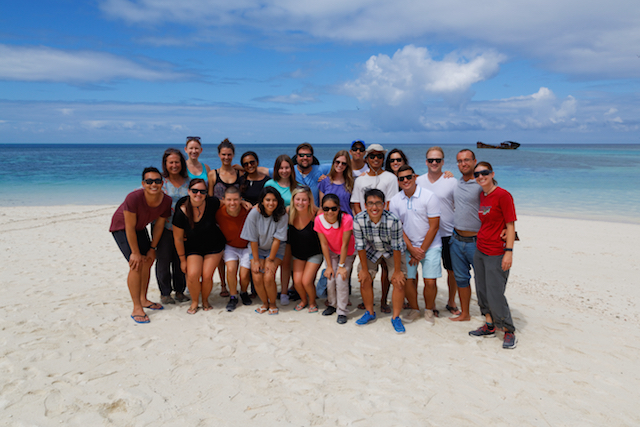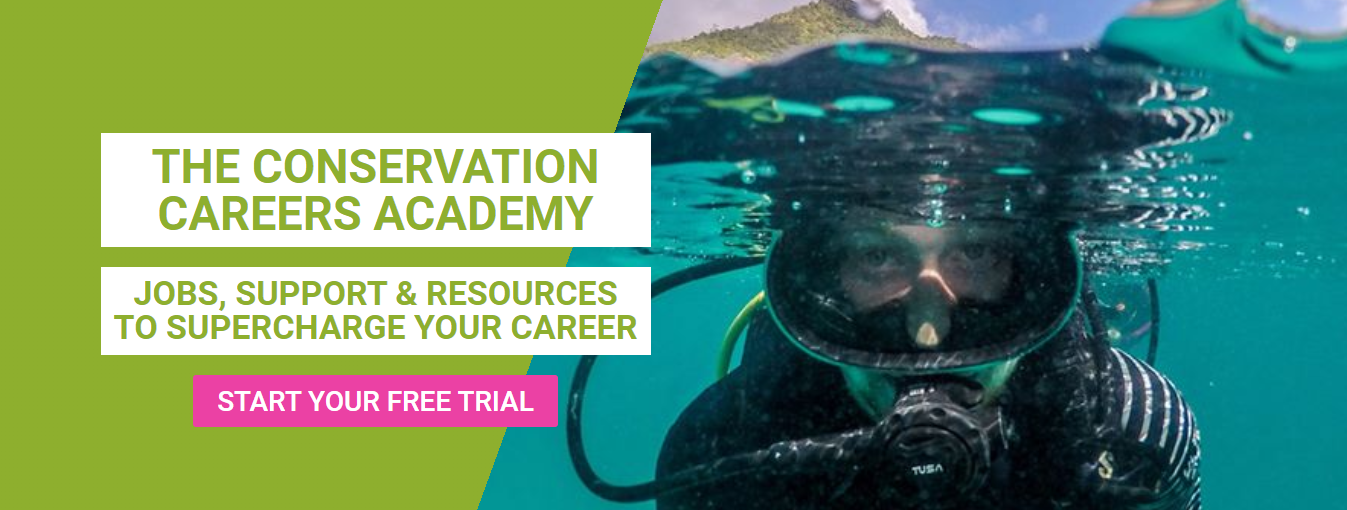
From Rainforests to Reefs: the Australian-based Conservation Master’s
With arid lands, rainforests and the Great Barrier Reef within roughly 1000 kilometres, plus a worldwide reputation for cutting-edge research in environment and ecology, the University of Queensland is an exciting place to train future conservationists. In 2013, the Australian university launched a one-year Master of Conservation Biology and an 18-month Master of Conservation Science, made up of twelve core courses plus an optional specialisation through research or coursework.
Here four lecturers explain what these programs offer students, from terrestrial and marine fieldwork to conservation planning and decision-making.

Collecting plant and invertebrate data to assess mine rehabilitation efforts at Stradbroke Island. Credit: Kristi Foster.
COMPREHENSIVE CONSERVATION TRAINING WITH DR BERNDT VAN RENSBURG, PROGRAM COORDINATOR
What is unique about the program’s approach to teaching?
More than 25 lecturers – academics, industry professionals and tutors – teach into the program, and we try to capitalise on their diverse research interests to create learning opportunities. The program has a large focus on field-based teaching and we take students into the field to collect biological data that often forms part of long-term research projects – invasive species in the outback, mine site restoration on a sand island, a 20-year project surveying kangaroo and wallaby populations.
A priority is to set a strong theoretical base in quantitative analysis and then challenge students to apply those skills on field data that they collect and take ownership of.

Dr Berndt van Rensburg.
How has the program helped the careers of previous graduates?
Past students have entered a variety of career paths related to conservation science and environment ranging from PhDs to government departments, NGOs and environmental education. Just this week I learned that a student is working for the Australian Government’s Department of Fisheries; another recently started working for Ash Meadows National Wildlife Refuge in the US; another works with the California Department of Fish and Wildlife.
Conservation is a diverse discipline and this program exposes students to a variety of scientists, industry professionals and potential research avenues that span different taxa and ecological systems. Many students who weren’t sure exactly what they wanted to focus on have told me that they found their niche through the master’s program.

A female green turtle returning to the sea after laying her eggs on Heron Island, where students learn techniques for surveying coral reefs. Credit: Michael Traurig.
Who is the program suited for and what background do you look for in applicants?
Ideal candidates come from any ecological or biological undergraduate background, or conservation or environmental science majors. But highly committed students with non-biological backgrounds can take pathway courses at UQ or abroad to prepare them for entry.
We cater for both students coming out of an undergraduate degree and professionals who want to step out of the working environment for a year to bump up their skills. We also cater for an international market but it’s important that students have a strong grasp of English reading and writing – UQ offers English training courses for this. Having a mix of academic and professional experience from around the world is what makes the program so dynamic.

Some of the 2015/16 cohort in Lamington National Park, learning what makes subtropical rainforest unique from other forest types. Credit: Chi Chiu Lo.
HANDS-ON CONSERVATION WITH ASSOCIATE PROFESSOR ANNE GOLDIZEN
What makes the opportunity to study in the field in Australia unique?
We have easier access to a wide range of natural and semi-natural habitats than just about anywhere else in the world. Besides the Great Barrier Reef, we have the outback, a unique example of arid and semi-arid lands. We’ve also got temperate and tropical rainforests, savannas, sand islands, heathland and other habitats. Sadly, Australia has more problems with introduced animals than most other countries. We also have the interesting aspect of the Indigenous population and their relationship to conservation.

Students tenting in the outback at Idalia National Park where an endangered bridled nail tail wallaby monitoring program has been ongoing for more than 20 years. Credit: Anne Goldizen.
Why is it so important for students to focus on field-based conservation learning?
Field-based learning brings together everything that the students have learned and makes sense out of it. Students see how the concepts they’ve studied explain what they see in the field. We also teach a lot of hands-on skills in this program – survey skills, trapping, all types of data collection – and get students to analyse their data using statistical skills that they’ve learned in the program R.

Associate Professor Anne Goldizen.
What field skills can students expect to gain from the Applied Fauna Conservation course?
We teach students survey skills to estimate the population densities of animals. We go spotlighting at night to estimate the densities of different kangaroo and wallaby populations in the outback and teach students how to use the program Distance to analyse the data.

Two Ecuadorian and one Chinese student collecting data at Idalia National Park. Credit: Anne Goldizen.
Having to collect their own data teaches students critical thinking and problem-solving skills – they’ve got to figure out how to collect the data, go collect it, deal with all the problems that arise in the field and then work through how to analyse the data with guidance.

Red kangaroos at Idalia National Park. Credit: Anne Goldizen.
LEADING-EDGE MARINE CONSERVATION WITH PROFESSOR PETER MUMBY
What trends can we expect to see in marine research and how does your research complement those trends?
The amount of effort going into research related to marine conservation is increasing dramatically. The problems are getting more acute, more people are aware and care about those problems and people are looking at more and more innovative solutions to deal with them. It’s a good field to be moving into!

Professor Peter Mumby. Credit: Colette Wabnitz.
There is an increasing shift towards understanding how ecosystems benefit people. Trying to create long-term partnerships with people in other disciplines like economics and social science is really important, and certainly something we try and do.
Do you have an example of work that used science to inform management?
We’ve done work quantifying the importance of mangroves as nursery habitats for reef fisheries that’s been used to help justify why people need to protect mangrove systems. We’ve done work looking at the effect of fishing on herbivorous fish in the Caribbean and how protecting those fish can modify the trajectories and health of coral reefs.
We look at how to design marine reserves to factor in climate change and connectivity and come up with methods that people can use to implement that. That work has been adapted and adopted in different parts of the Caribbean. As much as possible, we try to understand how marine systems work and use that information to determine areas to prioritise across seascapes.

An Epaulette shark off Heron Island, where students learn about coral reef ecology via lectures and day and night snorkels. Credit: Marina Richardson.
What skills and knowledge does the marine conservation course offer students?
It allows people to immerse themselves in science and management. Students spend a week on Heron Island, one of the pearls of the Great Barrier Reef, where they see some of the implementation and outcomes of very careful management. But they also gain an understanding of the underlying science needed to affect policy and management decisions.
We complement that with lectures and discussions that encourage students to think about some real world limitations and opportunities. The Great Barrier Reef is seen by many people as a shining example of good reef management, so there’s a lot to learn by studying it.

A turtle feeding on a jellyfish – with onlookers – at Heron Island. Credit: Claire Stewart.
CONSERVATION DECISION MAKING WITH PROFESSOR HUGH POSSINGHAM
We don’t always think about decision theory as a core part of conservation. What makes it so essential?
Conservation is an applied science; it’s all about helping people take actions. In the end, you only make something happen because you change policy or somebody takes an action on the ground. And the science of choosing between actions is decision science.
Everybody else in the world – engineers, economists, manufacturing industries, airlines – use decision science tools all the time. Even invasive species management and fisheries use decision science, and conservation is just starting to embrace it.

Professor Hugh Possingham.
How does conservation decision-making further transparency between different sectors?
It furthers transparency between industry, conservation and government – all the big players. Good decisions – for example where to place a national park – have lots of transparency because you list all the options available and then you tell people why you picked the ones you did and why you didn’t pick others. It should mean that everybody’s closer to the decision-making process.

Conservation decision-making can help inform which populations and ecosystems to protect and where. Credit: Muhammad Ichsan.
How has your work impacted conservation decisions and outcomes in Australia and beyond?
The conservation planning software Marxan is used by most of the countries in the world; it’s a spatial planning tool that supports the design of reserve systems. About 150 countries are actively using it to expand their marine or terrestrial park systems, including the national parks system in the Amazon. The Nature Conservancy uses it in 32 countries and South Africa c uses it at a local government level. We continually improve the tool and train people in using the tool – including master’s students!

Field-based learning with students from India, Australia, Canada, Scotland, China, the US and Brazil. Credit: Chi Chiu Lo.
Learn more about the Master of Conservation Biology and Master of Conservation Science at The University of Queensland including costs and how to apply.

